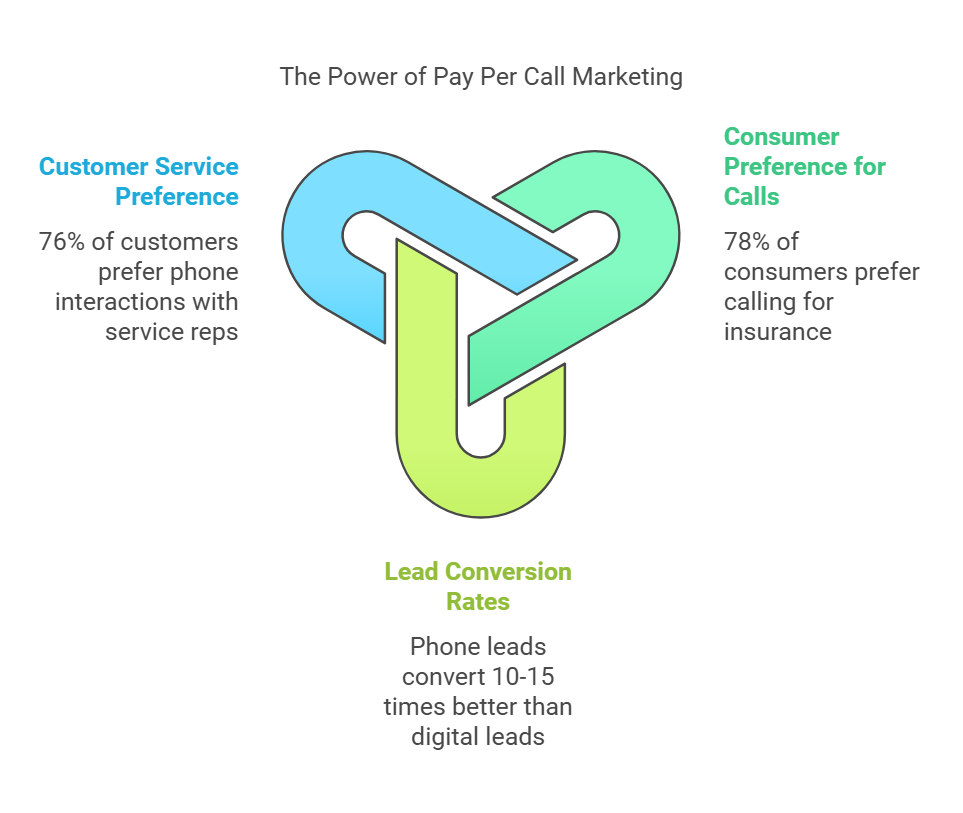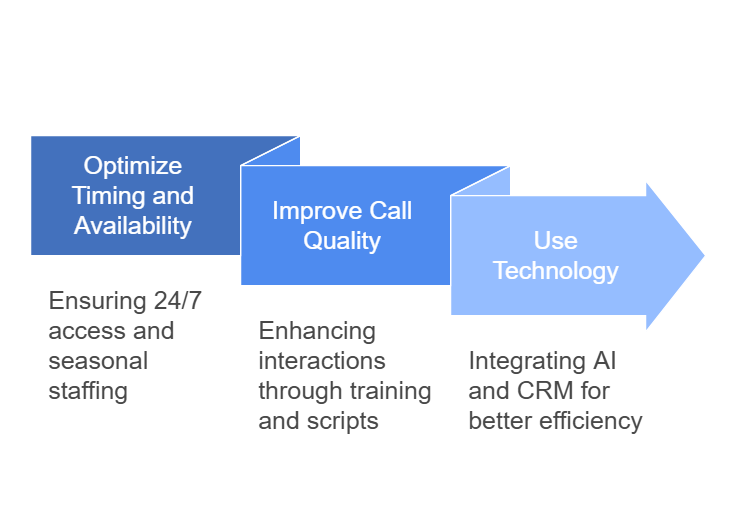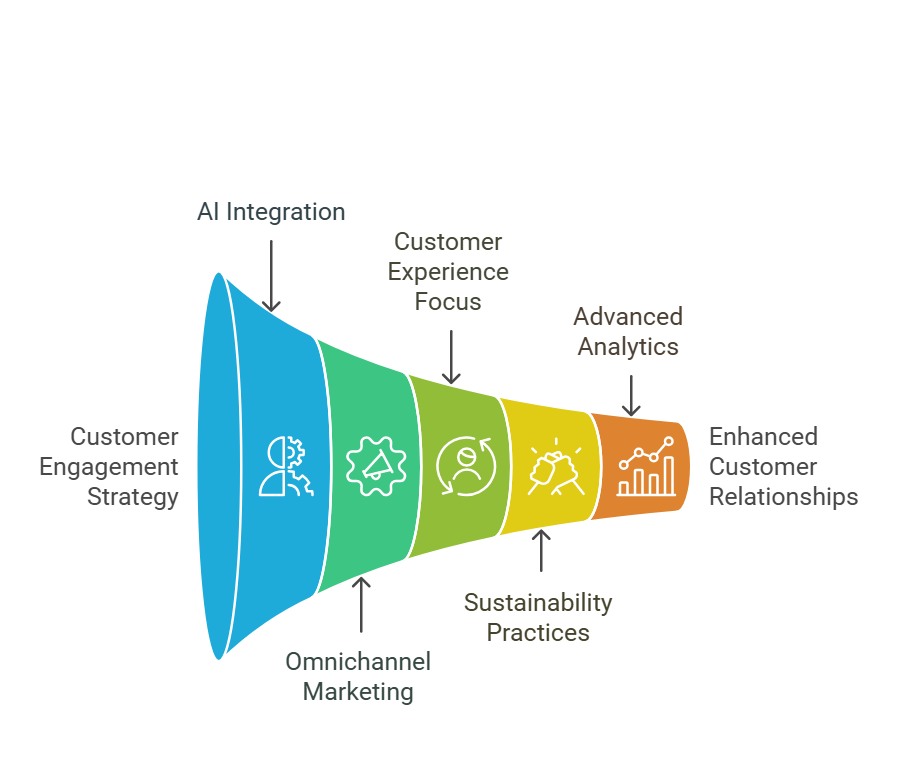
Pay-Per-Call Strategies for Successful in the Insurance Industry
Insurance companies are constantly seeking effective ways to connect with potential customers. While many marketing strategies focus on digital channels, Pay-Per-Call marketing is all about direct connection. This innovative approach combines the efficiency of digital marketing with the personal touch that insurance customers often seek.
In This post, we’ll explore this powerful tool for the insurance industry and how you can use it in your business for better results while creating stronger customer relationships.
Why Insurance and Pay-Per-Call Are a Perfect Match
The insurance industry is built on trust, detailed discussions, and personalized customer service. This makes Pay Per Call marketing an ideal strategy for engaging potential clients. Unlike simpler product transactions, purchasing insurance often involves questions, clarifications, and confidence, tasks that are best handled through personal interaction.
When considering coverage options for health, life, property, or business, customers want personalized solutions. Speaking directly with a knowledgeable insurance agent allows them to:
Address their specific needs and concerns.
Clearly understand complex policy details.
Receive immediate personalized quotes.
The effectiveness of Pay Per Call marketing is evident in these compelling statistics:
78% of consumers who search for insurance companies prefer to call rather than engage online, based on findings from Contentmarketing
Phone leads convert 10–15 times better than digital leads in the insurance sector, according to Invoca
76% of customers prefer speaking to customer service representatives by phone, this trend is supported by research published by Helpscout.

Key Benefits of Pay Per Call for Insurance Providers
Pay Per Call marketing offers special advantages for insurance providers. By facilitating direct communication with high-intent prospects, this strategy allows businesses to generate better leads, enhance customer relationships, and optimize marketing budgets.
1. Higher Quality Leads
Unlike traditional digital marketing methods, Pay Per Call connect insurance providers with prospects who are further along in the decision-making process. When a potential customer makes the effort to call, they are often:
Motivated Prospects: These customers are highly engaged and have specific needs.
Higher Conversion Potential: They are easier to qualify and more likely to convert.
Long-Term Value: These leads contribute to greater customer lifetime value due to their commitment.
2. Real-Time Customer Interaction
Direct phone communication allows insurance providers to engage with customers at critical moments, offering immediate and personalized assistance. These allow you the advantages of real-time conversations:
Instant Resolution: Customers can get answers to their questions without delay.
Customized Solutions: Agents can tailor coverage options based on the caller's unique circumstances.
Building Trust: Personal interaction fosters a stronger rapport with potential clients.
Additional Sales Opportunities: Agents can identify and recommend complementary products or policies.
3. Cost-Effective Marketing
While the cost per lead for Pay Per Call is often higher than digital methods, its efficiency and results make it a worthwhile investment for insurance providers. Here you have why pay per call is cost-effective:
Qualified Leads Only: Companies pay only for calls that meet predefined quality standards.
Improved ROI: The high conversion rates of Pay-Per-Call campaigns deliver a stronger return on investment.
Efficient Use of Resources: Marketing budgets are spent on high-quality interactions, reducing wasted efforts.
How to Implement Successful Strategies
Implementing a Pay Per Call marketing strategy requires careful planning and execution to maximize its effectiveness. These strategies ensure a smooth experience for both customers and providers.
1. Optimize Timing and Availability
To capture high-intent callers and convert leads effectively, insurance providers must prioritize timing and availability. Key strategies include:
24/7 Availability: Offering round-the-clock access ensures customers can connect whenever they need assistance, especially for emergency insurance inquiries.
Seasonal Staffing: Increasing staffing during peak periods, such as open enrollment or tax season, helps handle higher call volumes effectively.
Call Routing Expertise: Using intelligent call routing systems ensures that customers are connected to agents who specialize in the specific type of insurance they are seeking.
Call Recording and Monitoring: Recording calls allows for quality assurance, agent training, and identifying areas for improvement.
2. Improve Call Quality
The success of a Pay Per Call campaign depends on the quality of customer interactions. Insurance providers can increase their performance through:
Agent Training: Specialized training programs should prepare agents to handle Pay-Per-Call leads with professionalism and product expertise.
Detailed Scripts: Developing customized scripts for different insurance products ensures consistent and accurate messaging.
Call Tracking and Analytics: Implementing tools to monitor call performance helps identify patterns, track conversion rates, and optimize campaign strategies.
Regular Performance Reviews: Ongoing evaluation of agent performance and call outcomes allows for continuous improvement and adaptation.
3. Use Technology
Modern tools and technologies can further improve Pay-Per-Call campaigns by increasing efficiency and enhancing the customer experience:
AI Integration: Artificial intelligence can optimize call routing and provide agents with real-time insights during calls.
CRM Integration: Integrating customer relationship management systems ensures that all call data is tracked and utilized for follow-up and customer retention strategies.

How Pay-Per-Call is Transforming the Future of Insurance Marketing
The insurance industry is entering a new era, driven by rapid advancements in technology and changing consumer behaviors. To succeed in this expanding market, providers must adopt strategies that integrate digital innovation with the personal touch that customers value.
1. Rise of Artificial Intelligence and Automation
Artificial intelligence (AI) is transforming how insurance companies interact with their customers. By using AI, companies can:
Optimize Call Routing: Advanced systems ensure that customers are connected to the most qualified agents for their needs.
Enhance Personalization: AI analyzes customer data to provide customized policy recommendations in real-time.
Automate Routine Tasks: Chatbots and virtual assistants handle basic queries, freeing agents to focus on complex, high-value conversations.
2. Omnichannel Marketing Integration
Customers now expect easy interactions across multiple channels. The future of insurance marketing consists of creating unified experiences through:
Pay Per Call Marketing: Offering real-time conversations for high-intent leads.
Digital Channels: Complementing calls with targeted email campaigns, social media engagement, and website personalization.
Cross-Channel Analytics: Tracking customer behavior across all touchpoints to refine marketing strategies.
3. Increse Focus on Customer Experience
Customer satisfaction is becoming a key differentiator in the insurance market. Companies can be different by:
Provide Real-Time Assistance: Solutions like pay per call marketing ensure that customers’ questions are addressed immediately.
Personalize the Experience: Using data to understand customer needs and deliver relevant offers.
Build Trust: Transparent communication and responsive service foster long-term relationships.
4. Sustainability and Social Responsibility
Modern consumers choose companies that align with their values. Insurance providers can attract and retain customers by:
Prioritize Sustainability: Adopting environmentally sustainable practices.
Highlight Ethical Policies: Marketing that emphasizes transparency and customer-first initiatives.
Use Authentic Interactions: Pay Per Call can be used to humanize their brand and connect meaningfully with customers.
5. Use Advanced Analytics
Data-driven decision-making is influencing the future of marketing. By using analytics, insurance providers can:
Identify High-Value Leads: Focus on the customers most likely to convert.
Optimize Campaigns: Use real-time insights to refine strategies and improve performance.
Measure ROI: Track the success of Pay Per Call campaigns alongside other marketing efforts.
Pay-Per-Call marketing gives you the chance to talk directly to people who need your help, answer their questions, and build trust. By using this approach, you can grow your business while giving customers the personal support they value, and making real connections with them.

Give Personal Support to Your Customers in the Insurance Industry with UNIK360
Pay-Per-Call marketing gives you the chance to talk directly to people who need your help, answer their questions, and build trust. By using this approach, you can grow your business while giving customers the personal support they value.
For insurance providers looking for the best way to implement this strategy, UNIK360 is your best option. With expertise in Pay-Per-Call campaigns, creatives, and tools, UNIK360 ensures you connect with high-quality leads and achieve measurable results.
Create your account and let UNIK360 help you exploit the full potential of Pay-Per-Call marketing.
Frequently Asked Questions About Pay Per Call for Insurance Industry
Is Pay-Per-Call Suitable for All Types of Insurance?
Yes, Pay-Per-Call is versatile and can be applied to various types of insurance, including health, life, auto, home, and business insurance. However, its success depends on factors such as the complexity of the insurance product, the target audience, and the effectiveness of your campaign strategies.
Can Pay-Per-Call Increase Customer Lifetime Value?
Yes, Pay-Per-Call often leads to higher customer lifetime value (CLV). Since phone leads are more likely to convert into paying customers, the relationship built during the initial call lays the foundation for long-term engagement. Agents can also use the opportunity to cross-sell or upsell additional coverage options.
How Do Insurance Providers Qualify Pay-Per-Call Leads?
Leads are qualified based on predefined criteria, such as:
The caller's intent (e.g., requesting a quote or seeking coverage information).
Call duration (e.g., lasting longer than 60 seconds).
The caller’s location and eligibility for the insurance product offered.
What Are the Risks of Pay-Per-Call Marketing in Insurance?
While highly effective, some risks include:
Fraudulent Calls: Calls made with no genuine intent to purchase. Using call-tracking software can mitigate this risk.
Missed Opportunities: Failing to answer calls promptly can result in lost leads. Ensuring 24/7 availability and proper staffing is crucial.
High Cost Per Call: While the cost per call may be higher than digital leads, the superior conversion rates justify the investment when managed effectively.
